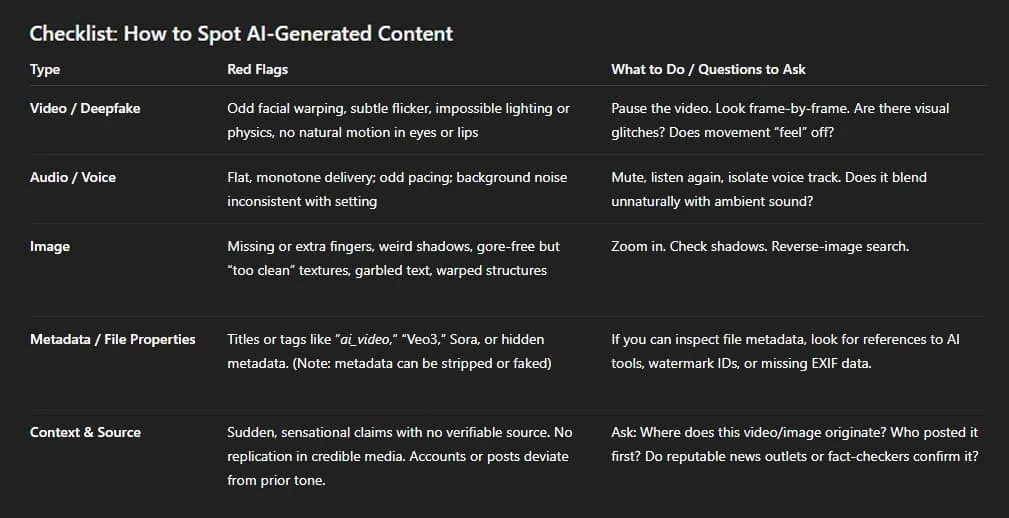When “Seeing Is Believing” Isn’t Enough: How to Spot AI Fakes Before You Share
There was a time when a photo or video was proof.
If you saw it, it happened.
Not anymore.
We’re now living in an age where computers can create incredibly realistic fake photos and videos — complete with voices, movement, and emotions — that look just like the real thing.
What’s Happening
New tools like OpenAI’s Sora can make full video scenes from just a few typed words. These programs often leave behind small watermarks or hidden digital tags to show the content was made by AI — but some people have already found ways to remove them.
That means even posts from accounts you trust could include computer-generated (AI) images or videos without anyone realizing it.
Why This Matters
Trust is the target.
When people can’t tell what’s real anymore, everything becomes questionable — news reports, scientific evidence, even personal stories. Once that happens, it’s easy for misinformation to spread.
Lies travel faster.
One person can now create and share hundreds of fake videos or posts in just a few hours. These can be used to trick people, sell false ideas, or even influence elections.
Accountability disappears.
If someone is caught on video doing something wrong, they can now claim, “That’s not me — it’s AI.” Suddenly, even real evidence can be doubted.
How to Spot an AI Fake
AI-made content often has small details that don’t quite fit.
Here’s what to look for before believing or reposting:
-
In pictures: hands or eyes that look strange, text that’s unreadable, shadows that don’t line up.
-
In videos: people who blink oddly, mouths that move out of sync, lighting that changes suddenly.
-
In sound clips: voices that sound flat or robotic, background noise that doesn’t match the setting.
-
In posts: stories that seem too dramatic, too emotional, or come from accounts that don’t normally post about that topic.
If something feels “off,” trust that feeling. Take a moment to search for the same story on other reliable sites before sharing.
✅ Before You Repost or Believe, Pause & Ask
-
Does this seem too dramatic or too perfect?
-
Who posted it first — and can I find the same story somewhere credible?
-
Are there any strange visual or audio details?
-
Why might someone want me to believe or share this?
Taking ten seconds to check could stop a false story from spreading to thousands of people.
About AI Art and Creativity
AI image tools can be exciting and useful — for design, education, and creative exploration.
But it’s important to know that many AI systems learn by analyzing millions of artworks created by real people, often without those artists’ permission.
That means while the technology is powerful, the way it’s trained raises serious questions about fairness and respect for original creators.
We support ethical innovation — tools that create responsibly, not those that copy without consent.
The Takeaway
We don’t need to fear AI, but we do need to be smarter about it.
Before you click “share,” take a moment to pause, look closer, and think critically.
Because in a world where anyone can fake reality, the most powerful truth detector is still you.
Alchemy I.T.
Empowering people with the knowledge to stay safe, smart, and informed in the digital age.
203 Silverstone Crescent, Stony Plain, AB
T: 780-218-5771
T: 780-983-6051
E: help@alchemyit.ca
About Alchemy I.T.
We provide expert computer repair and IT support for homes and businesses in Stony Plain, Spruce Grove, Acheson, and Carvel. With more than 55 years of combined experience, our team offers trusted solutions in computer repair, virus removal, data recovery, and managed IT services.
Unlike many competitors, we provide free basic diagnostics, charge no rush fees, and are available 7am–10pm, seven days a week. It’s our commitment to making technology reliable, affordable, and stress-free for our community.



